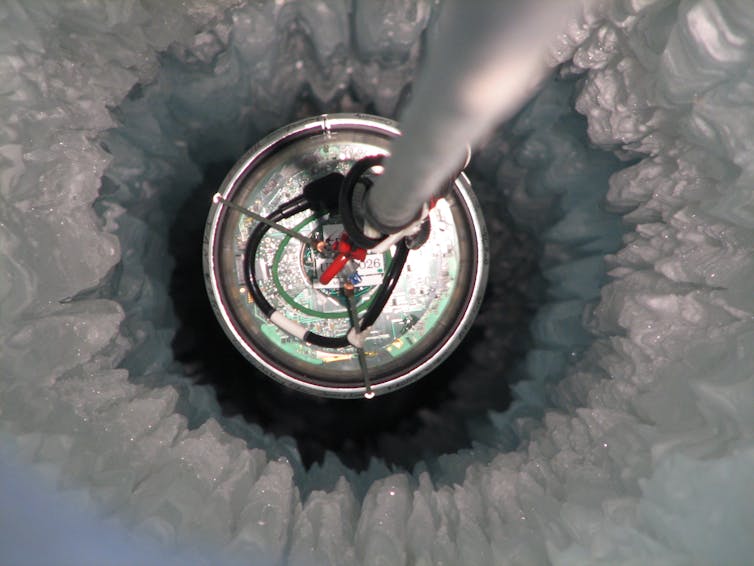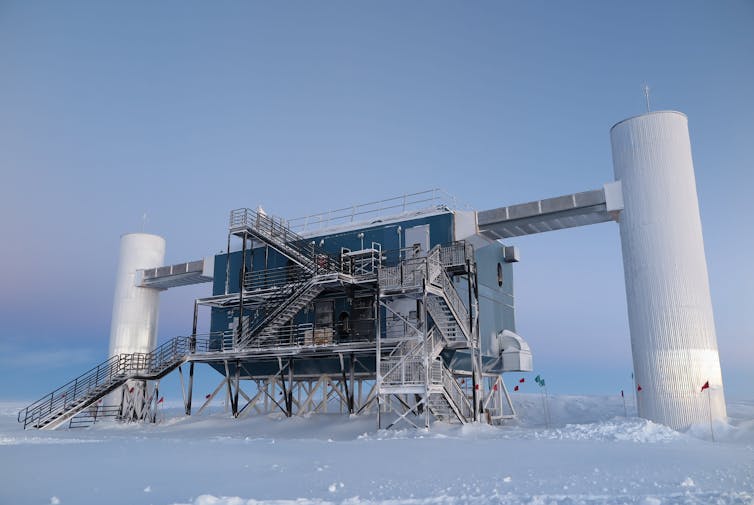
The Milky Way, as seen with neutrino particles.
IceCube Collaboration / US National Science Foundation (Lily Le and Shawn Johnson) / ESO (S. Brunier)
Subir Sarkar
Published: June 30, 2023
Subir Sarkar
Published: June 30, 2023
THE CONVERSATION
Data collected by an observatory in Antarctica has produced our first view of the Milky Way galaxy through the lens of neutrino particles. It’s the first time we have seen our galaxy “painted” with a particle, rather than in different wavelengths of light.
The result, published in Science, provides researchers with a new window on the cosmos. The neutrinos are thought to be produced, in part, by high-energy, charged particles called cosmic rays colliding with other matter. Because of the limits of our detection equipment, there’s much we still don’t know about cosmic rays. Therefore, neutrinos are another way of studying them.
It has been speculated since antiquity that the Milky Way we see arching across the night sky consists of stars like our Sun. In the 18th century, it was recognised to be a flattened slab of stars that we are viewing from within. It is only 100 years since we learnt that the Milky Way is in fact a galaxy, or “island universe”, one among a hundred billion others.
In 1923, the American astronomer Edwin Hubble identified a type of pulsating star called a “Cepheid variable” in what was then known as the Andromeda “nebula” (a giant cloud of dust and gas). Thanks to the prior work of Henrietta Swan Leavitt, this provided a measure of the distance from Earth to Andromeda.
Join thousands of Canadians who subscribe to free evidence-based news.Get newsletter
This demonstrated that Andromeda is a far away galaxy like our own, settling a long-running debate and completely transforming our notion of our place in the universe.
Opening windows
Subsequently, as new astronomical windows have opened on to the sky, we have seen our galactic home in many different wavelengths of light –- in radio waves, in various infrared bands, in X-rays and in gamma-rays. Now, we can see our cosmic abode in neutrino particles, which have very low mass and only interact very weakly with other matter – hence their nickname of “ghost particles”.
Neutrinos are emitted from our galaxy when cosmic rays collide with interstellar matter. However, neutrinos are also produced by stars like the Sun, some exploding stars, or supernovas, and probably by most high-energy phenomena that we observe in the universe such as gamma-ray bursts and quasars. Hence, they can provide us an unprecedented view of highly energetic processes in our galaxy – a view that we can’t get from using light alone.

A digital operating module, part of the IceCube observatory, being lowered into the ice.
Mark Krasberg, IceCube/NSF, Author provided
The new breakthrough detection required a rather strange “telescope” that is buried several kilometres deep in the Antarctic ice cap, under the South Pole. The IceCube Neutrino Observatory uses a gigatonne of the ultra-transparent ice under huge pressures to detect a form of energy called Cherenkov radiation.
This faint radiation is emitted by charged particles, which, in ice, can travel faster than light (but not in a vacuum). The particles are created by incoming neutrinos, which come from cosmic ray collisions in the galaxy, hitting the atoms in the ice.
Cosmic rays are mainly proton particles (these make up the atomic nucleus along with neutrons), together with a few heavy nuclei and electrons. About a century ago, these were discovered to be raining down on the Earth uniformly from all directions. We do not yet definitively know all their sources, as their travel directions are scrambled by magnetic fields that exist in the space between stars.
Deep in the ice
Neutrinos can act as unique tracers of cosmic ray interactions deep in the Milky Way. However, the ghostly particles are also generated when cosmic rays hit the Earth’s atmosphere. So the researchers using the IceCube data needed a way to distinguish between the neutrinos of “astrophysical” origin – those originating from extraterrestrial sources – and those created from cosmic ray collisions within our atmosphere.
The researchers focused on a type of neutrino interaction in the ice called a cascade. These result in roughly spherical showers of light and give the researchers a better level of sensitivity to the astrophysical neutrinos from the Milky Way. This is because a cascade provides a better measurement of a neutrino’s energy than other types of interactions, even though they they are harder to reconstruct.

The new breakthrough detection required a rather strange “telescope” that is buried several kilometres deep in the Antarctic ice cap, under the South Pole. The IceCube Neutrino Observatory uses a gigatonne of the ultra-transparent ice under huge pressures to detect a form of energy called Cherenkov radiation.
This faint radiation is emitted by charged particles, which, in ice, can travel faster than light (but not in a vacuum). The particles are created by incoming neutrinos, which come from cosmic ray collisions in the galaxy, hitting the atoms in the ice.
Cosmic rays are mainly proton particles (these make up the atomic nucleus along with neutrons), together with a few heavy nuclei and electrons. About a century ago, these were discovered to be raining down on the Earth uniformly from all directions. We do not yet definitively know all their sources, as their travel directions are scrambled by magnetic fields that exist in the space between stars.
Deep in the ice
Neutrinos can act as unique tracers of cosmic ray interactions deep in the Milky Way. However, the ghostly particles are also generated when cosmic rays hit the Earth’s atmosphere. So the researchers using the IceCube data needed a way to distinguish between the neutrinos of “astrophysical” origin – those originating from extraterrestrial sources – and those created from cosmic ray collisions within our atmosphere.
The researchers focused on a type of neutrino interaction in the ice called a cascade. These result in roughly spherical showers of light and give the researchers a better level of sensitivity to the astrophysical neutrinos from the Milky Way. This is because a cascade provides a better measurement of a neutrino’s energy than other types of interactions, even though they they are harder to reconstruct.

The IceCube Observatory is located at the South Pole.
Erik Beiser, IceCube/NSF, Author provided
Analysis of ten years of IceCube data using sophisticated machine learning techniques yielded nearly 60,000 neutrino events with an energy above 500 gigaelectronvolts (GeV). Of these, only about 7% were of astrophysical origin, with the rest being due to the “background” source of neutrinos that are generated in the Earth’s atmosphere.
The hypothesis that all the neutrino events could be due to cosmic rays hitting the Earth’s atmosphere was definitively rejected at a level of statistical significance known as 4.5 sigma. Put another way, our result has only about a 1 in 150,000 chance of being a fluke.
This falls a little short of the conventional 5 sigma standard for claiming a discovery in particle physics. However, such emission from the Milky Way is expected on sound astrophysical grounds.
With the upcoming enlargement of the experiment – IceCube-Gen2 will be ten times bigger – we will acquire many more neutrino events and the current blurry picture will turn into a detailed view of our galaxy, one that we have never had before.
Analysis of ten years of IceCube data using sophisticated machine learning techniques yielded nearly 60,000 neutrino events with an energy above 500 gigaelectronvolts (GeV). Of these, only about 7% were of astrophysical origin, with the rest being due to the “background” source of neutrinos that are generated in the Earth’s atmosphere.
The hypothesis that all the neutrino events could be due to cosmic rays hitting the Earth’s atmosphere was definitively rejected at a level of statistical significance known as 4.5 sigma. Put another way, our result has only about a 1 in 150,000 chance of being a fluke.
This falls a little short of the conventional 5 sigma standard for claiming a discovery in particle physics. However, such emission from the Milky Way is expected on sound astrophysical grounds.
With the upcoming enlargement of the experiment – IceCube-Gen2 will be ten times bigger – we will acquire many more neutrino events and the current blurry picture will turn into a detailed view of our galaxy, one that we have never had before.
Author
Subir Sarkar
Emeritus professor, University of Oxford
Disclosure statement
Subir Sarkar received funding from the University of Oxford to support his participation in IceCube.
Partners
Emeritus professor, University of Oxford
Disclosure statement
Subir Sarkar received funding from the University of Oxford to support his participation in IceCube.
Partners
No comments:
Post a Comment